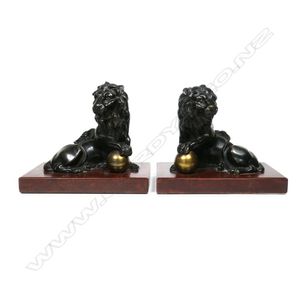Bronze Imperial Lion Bookends on Porphyry Bases
A pair of bronze Imperial lion bookends, modelled in mirrored recumbent position each with foreleg raised on a sphere. On faux porphyry wooden bases, width 14.5 cm
You must be a subscriber, and be logged in to view price and dealer details.
Subscribe Now to view actual auction price for this item
When you subscribe, you have the option of setting the currency in which to display prices to $Au, $US, $NZ or Stg.
This item has been sold, and the description, image and price are for reference purposes only.
- Porphyry - In geology, porphyry is a type of igneous rock with a distinctive texture. It has large, visible crystals (called phenocrysts) embedded in a fine-grained groundmass. In the ancient world, porphyry was a highly prized material used for sculptures, sarcophagi, and other decorative objects. Porphyry wasn't widely used in furniture throughout the 19th century, but was used as a luxury and prestigious material.
Due to its high cost and difficulty in working with, porphyry was primarily used for smaller accent pieces or decorative elements on furniture. This could include tabletops, inlays, veneers, or ornamental details on legs or columns. It was also used for furniture pieces commissioned for royalty, wealthy patrons, or important public buildings. For example, some European palaces feature furniture with porphyry elements. - Faux - A French word meaning "false", but when used in decorative arts, the intention is not to deceive, but to simulate the decorative effects of the more expensive material it is imitating. The term " faux bois" meaning "false wood" refers to a furniture item that has been decorated with a marked grain (woodgrain finish) to imitate a more expensive timber.
- Bronze - An alloy of copper and tin, traditionally in the proportions of about 9 parts of copper to 1 part of tin.
The discovery of bronze in Western Asia in the 4th century enabled people to create metal objects which were superior to those previoulsy possible because of its strength and hardness, and it has been used throughout the world for weapons, coins, tools, statuary and other decorative items.
It is very fluid in a molten state, and its hardness, strength when set, and non-corrosive properties makes it most suitable for casting sculpture.
This item has been included into following indexes:
